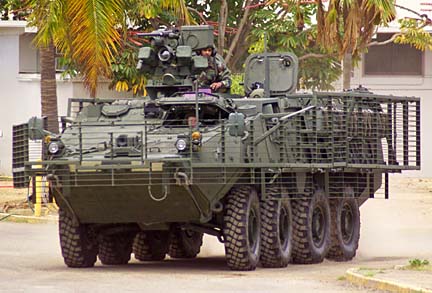
Tank commander Michael Embry showed off the instrumentation of his Stryker vehicle yesterday at Ford Island. From his seat, he can fire the gun above him and pinpoint his location on a map.
Public gets look
at Army’s futureThree Stryker vehicles and
a vessel that will carry them
into battle are displayed on Oahu
CORRECTION
Wednesday, July 28, 2004Michael Embry was explaining the features of a U.S. Army Stryker vehicle Monday at Ford Island. A photo caption on Page A3 in yesterday's early edition incorrectly labeled the Stryker as a tank.
The Honolulu Star-Bulletin strives to make its news report fair and accurate. If you have a question or comment about news coverage, call Editor Frank Bridgewater at 529-4791 or email him at corrections@starbulletin.com.
More than 50 local politicians, foreign dignitaries and military supporters got a glimpse yesterday of the future of the U.S. Army in the Pacific: three 19-ton Stryker combat vehicles and a twin-hulled, high-speed cargo vessel.
They rode in a Stryker around a Ford Island parking lot. They also walked through the retrofitted commercial ferry, the High Speed Vessel (HSV-X1) Joint Venture, which can carry 325 soldiers and 40 Strykers.
Strykers on Oahu
The Strykers will be on display on Oahu this week at:>> Alii Beach Park in Haleiwa, at 66-167 Haleiwa Road, today from 5 to 7:30 p.m.
>> Wahiawa District Park in Wahiawa, at 1139 Kilani Ave., tomorrow from 5 to 7:30 p.m.
>> Waianae Intermediate School in Waianae, on Thursday from 5 to 7:30 p.m.
Lt. Gen. James Campbell, Army Pacific commanding general, said the 313-foot catamaran and a new squadron of eight C-17 jet cargo transports being planned for Hickam Air Force Base will "enable us to move the Strykers rapidly in this theater."
Maj. Gen. William Brandenburg, Army Pacific deputy commanding general, said the proposal calls for four of these wave-piercing catamarans to be berthed in the Pacific, with one or two possibly assigned to Hawaii.
The 25th Infantry Division's Stryker brigade will be the fifth of six planned for the Army. The unit's 291 Stryker vehicles are scheduled to start arriving in Hawaii in May 2006.
Brandenburg, who helped with the formation of the Army's first two Stryker brigades while stationed at Fort Lewis, Wash., said the 25th Infantry Division is part of a major reorganization announced on Friday. He said the division's 3rd Brigade will be also rebuilt.
The Army predicts that during the next seven years, all of its brigades will only have three types of fighting units: armor, infantry and Stryker.
"This is a reduction in the number of type of brigades" in the Army currently, Brandenburg said. "We got air assault, airborne, light infantry, mechanized infantry and armor brigades."
Brandenburg said the change will make the Army more adaptable to meet any conflict, and "it is a recognition of the way we have been employing forces over the last 10 or 15 years."
Brandenburg said the only increase in number of soldiers at Schofield Barracks will be the 810 planned for 2007 when the 25th Infantry Division's 2nd Brigade is converted to a Stryker unit. The 3rd Brigade, after the reorganization, will consist of 3,600 soldiers drawn from existing units at Schofield. The Stryker Brigade will have the same amount of soldiers.
The Army embarked this week on a public awareness campaign to try "to dispel the myths" about the eight-wheeled vehicles.
Journalists were taken for a test ride in one of the Army's new Stryker vehicles yesterday at Ford Island.
The Army brought in two versions of the Stryker -- which can be configured in 10 different ways -- and seven Stryker crew members from Alaska and one from Washington. One of the Strykers -- configured to carry nine soldiers and a two-man crew -- also sported what has been described as a large catcher's mask that surrounds the vehicle to protect it from rocket-propelled grenades.Capt. Cathy Turner, 25th Division spokeswoman, said yesterday that on the Big Island, about 200 people showed up at Waimea on Saturday and 1,000 in Hilo on Sunday to check out the vehicles.
"It was an overwhelming positive response," said Turner.
She acknowledged, however, that each stop did draw protesters, most of whom fear the Stryker vehicles will damage the environment.
Soldiers from Fort Lewis and Fort Wainwright, Alaska, said they appreciated how quiet the vehicle was even when it was approaching its high-end speed of 65 mph.
"And we don't bounce around while riding in it like in a tracked vehicle like the Bradley," said 1st Lt. Christopher Todd, a fire support officer with the Alpha Company, 1st Battalion, 17th Infantry at Fort Wainwright.
Pfc. John Chiment, a Stryker driver and radio operator from Fort Wainwright, said the vehicle drives like a truck; it is controlled by a steering wheel and has an automatic transmission.
The Strykers also are equipped with heat vision cameras, "so it can be driven when it is completely zippered up."
"With these thermal sights," Chiment said, "you can actually see divots in the road as black or white images."

